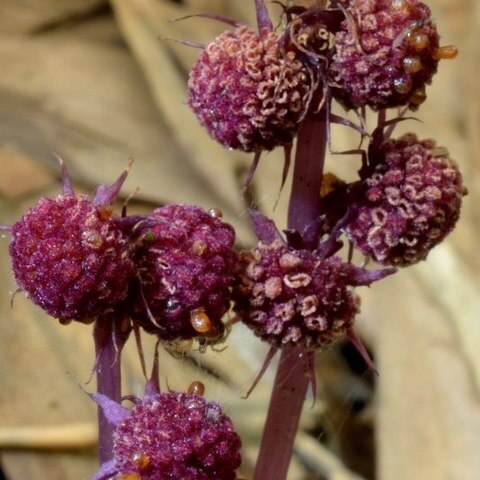Small and delicate, echlorophyllose, mostly erect, simple or branched herbs up to c. 45 cm high (in Mal.). Rhizome often with a few scale-like leaves, sometimes branched, mostly with hairs. Stem usually glabrous, sometimes with air-roots, descending from both sides of the leaves (up to 5 cm of the stem). Leaves scale-like, scattered, spaced, sessile, mostly appressed, sometimes amplexicaul. Inflorescences terminal, racemose, all around or most flowers to one side, with male and female flowers, or male and bisexual flowers, or only bisexual flowers. Monoecious; female flowers usually in the upper part of the raceme. Flowers actinomorphic, perianth with 4-10, usually 6, valvate, patent or reflexed, equal or alternatingly unequal (larger and smaller) segments, connate at base, at the top glabrous or bearded by uniseriate hairs, or with knob-like appendages. ♂ Flowers: with 2-3 or 6 sessile or ± sessile, epitepalous (in Triuris alternitepalous) stamens, in case there are 2 or 3 stamens they are in front of the larger segments; anthers 1-4-celled, 2-4-lobed, first opening transversally, later also longitudinally; filaments sometimes far exceeding the dorsifixed anthers, rarely connate at base. ♀ Flowers: with c. 10-80 obovoid, free ovaries, each with 1 orthotropic, later anatropic ovule; style inserted laterally and adaxially, usually exceeding the ovary, club-or awl-shaped, in the former case with many hairs and papillae, in the latter with glabrous apex. Bisexual flowers: with (2-) 3-6 persistent stamens with clearly visible filaments, anthers 1-celled, 2-3-lobed; ovaries c. 10-50, like in the female flowers, but the style always club-shaped. Fruits obovoid, 3-8 times as large as the ovaries, with persistent, partly shrivelled style, dehiscent lengthwise from the apex, first abaxially, later also adaxially. Seed 1, endospermous, elliptic to ovate, the surface netted and mostly lined, sometimes with a dent. Endosperm present; embryo small, orthotropous, undifferentiated, bitegmic, only in ripe seed the inner integument wholly or largely suppressed.
More
Monoecious or rarely bisexual. Leaves scale-like, sessile, mostly appressed, sometimes amplexicaul (not in Australia). Inflorescence a terminal raceme, with flowers either spirally alternating or most to one side. Flowers: tepals with apex glabrous or bearded, or with knoblike appendages. Male flowers: stamens 2–6, epitepalous, sessile or ±sessile; filaments sometimes prolonged well beyond anthers; anthers opening transversely initially, later also longitudinally. Female flowers: ovaries c. 10–80, obovoid; style lateral, usually exceeding ovary, with glabrous or papillate apex. Fruit a follicle, obovoid, much larger than ovary, with persistent style, dehiscing ventro-dorsally from apex. Seed 1.
Roots with hairs. Stems short, slender. Inflorescences racemose. Flowers unisexual or bisexual, pedicellate. Perianth segments 3-8(-10). Stamens 2, 3, or 6; filaments absent or very short; anthers 3-or 4-thecous; connectives not produced into appendages. Carpels numerous; style lateral or basal. Follicles opening by a longitudinal slit.
Small colorless or purplish saprophytic herbs. Leaves alternate, reduced to narrow scales. Inflorescence terminal, racemose, bearing few to numerous small, monoecious, hermaphrodite or unisexual flowers. Perianth campanulate, segments virtually uniform, 4-10; stamens 2-6; carpels numerous, free; staminodia and pistillodia lacking.
Anthers sessile or subsessile at the base of the perianth
Perianth 3-8-partite or deeply lobed
Style ventral or basal in fruit
Saprophytes in humous soil between litter of rain-forest, often associated in local saprophyte 'colonies' with species of Burmanniaceae, tiny orchids, and Epirixanthes (Polygal.). Mostly at low altitude, ascending to c. 1200 m, very rarely higher, up to 2200 m altitude.The root system carries endotrophic mycorrhiza.

